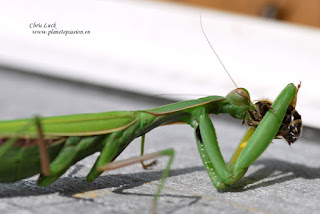Older French stone built houses invariably play host to a number of species and that includes these fascinating little guests although not all people are thrilled by their presence or their speed when they get a move on reaching speeds of up to 0.4 meters per second.
Although in everyday usage they are called a centipede or “hundred feet” they actually only have 15 pairs of legs when fully grown giving them 30 legs. The last 2 legs are particularly long, longer in fact than their antennae reaching twice the length of the body and can be nearly 6 cm. They use these long legs to form a kind of lasso which is one of the methods they use to capture prey.
Note that the common terms centipede and millipede are never meant to be factual and both are grouped together as myriapods or very many-footed.
Eggs are laid in spring and the larvae when they hatch look like miniature versions of the adult but with only 4 pairs of legs. They gain a new pair with the first moult and two pairs with each of their five subsequent moults. Adults with 15 pairs of legs retain that number through three more moulting stages (sequence 4-5-7-9-11-13-15-15-15-15 pairs). They have a lifespan that is from 3 to 8 years with sexual maturity reached in the third year.
Mating can be tricky with the male and female circling around each other making contact with their antennae with this being the only contact they will make. The male then deposits his sperm on the ground which the female collects and uses to fertilise herself.
Prey is killed or disabled using venom that is delivered using Forcipules which are a unique feature found only in centipedes and in no other arthropods. These are modifications of the first pair of legs that form a pincer-like appendage always found just behind the head.
Venom glands run through a tube almost to the tip of each forcipule. It’s highly unlikely that these would be used on a human being unless it was trapped with no available escape such as being held in a closed hand or caught in clothing. Prey can be almost any insect including wasps and hornets and as such they can be a useful creature to have around the home as they quietly go about their nocturnal searches for food.
Chris





























